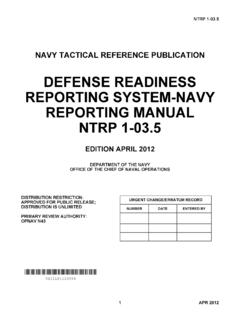Transcription of mêçÅÉÉÇáåÖë= - Defense Technical Information Center
1 SYM-AM-15-098. m =. = =. q =^ ~ =^ =. o ~ =p =. q ~ =p =. s =ff= =. OSD's Obligation & Expenditure Rate Goals: An Examination of the Factors Contributing to the Interference Robert Tremaine, DAU. Donna J. Seligman, DAU. Published April 30, 2015. Disclaimer: The views represented in this report are those of the author and do not reflect the official policy position of the Navy, the Department of Defense , or the federal government. ^ =o ~ =m ~ =. d ~ ~ =p = =_ =C=m =m =. k~ ~ =m ~ ~ =p =. Form Approved Report Documentation Page OMB No.
2 0704-0188. Public reporting burden for the collection of Information is estimated to average 1 hour per response, including the time for reviewing instructions, searching existing data sources, gathering and maintaining the data needed, and completing and reviewing the collection of Information . Send comments regarding this burden estimate or any other aspect of this collection of Information , including suggestions for reducing this burden, to Washington Headquarters Services, Directorate for Information Operations and Reports, 1215 Jefferson Davis Highway, Suite 1204, Arlington VA 22202-4302.
3 Respondents should be aware that notwithstanding any other provision of law, no person shall be subject to a penalty for failing to comply with a collection of Information if it does not display a currently valid OMB control number. 1. REPORT DATE 3. DATES COVERED. 2. REPORT TYPE. 30 APR 2015 00-00-2015 to 00-00-2015. 4. TITLE AND SUBTITLE 5a. CONTRACT NUMBER. OSD's Obligation & Expenditure Rate Goals: An Examination of the 5b. GRANT NUMBER. Factors Contributing to the Interference 5c. PROGRAM ELEMENT NUMBER. 6. AUTHOR(S) 5d.
4 PROJECT NUMBER. 5e. TASK NUMBER. 5f. WORK UNIT NUMBER. 7. PERFORMING ORGANIZATION NAME(S) AND ADDRESS(ES) 8. PERFORMING ORGANIZATION. REPORT NUMBER. Defense Acquisition University West Region,33000 Nixie Way Bldg 50,San Diego,CA,92147-5117. 9. SPONSORING/MONITORING AGENCY NAME(S) AND ADDRESS(ES) 10. SPONSOR/MONITOR'S ACRONYM(S). 11. SPONSOR/MONITOR'S REPORT. NUMBER(S). 12. DISTRIBUTION/AVAILABILITY STATEMENT. Approved for public release; distribution unlimited 13. SUPPLEMENTARY NOTES. 14. ABSTRACT. Managing DoD acquisition programs is a complicated process.
5 The turbulence created by funding instability makes it even more difficult. To help program offices maintain their overall funding execution pace, the Office of the Secretary of Defense (OSD) instituted Obligation and Expenditure rate goals over two decades ago. Acquisition program managers have found it difficult to meet established Obligation and Expenditure rate goals. For the purposes of this study (sponsored by Nancy Spruill, director of Acquisition Resources and Analysis, Office of the Under Secretary of Defense for Acquisition, Technology and Logistics) and based on Defense Acquisition University and OSD subject matter expertise, the authors looked closely at potential causal factors that could be interfering with the achievement of these goals.
6 Two hundred and twenty-nine DoD personnel responded to a comprehensive survey. The respondents were comprised of program office personnel (program managers [PMs], deputy PMs, budget and financial managers [FMs], and contracting officers); program executive officers (PEOs) and their chief financial officers; and a variety of senior OSD staff including Headquarters FM senior staff and Senior Acquisition Executive staff. The respondents were asked if they found metrics helpful in better meeting OSD goals as well as the use of any process improvements.
7 15. SUBJECT TERMS. 16. SECURITY CLASSIFICATION OF: 17. LIMITATION OF 18. NUMBER 19a. NAME OF. ABSTRACT OF PAGES RESPONSIBLE PERSON. a. REPORT b. ABSTRACT c. THIS PAGE Same as 19. unclassified unclassified unclassified Report (SAR). Standard Form 298 (Rev. 8-98). Prescribed by ANSI Std Z39-18. The research presented in this report was supported by the Acquisition Research Program of the Graduate School of Business & Public Policy at the Naval Postgraduate School. To request Defense acquisition research, to become a research sponsor, or to print additional copies of reports, please contact any of the staff listed on the Acquisition Research Program website ( ).
8 ^ =o ~ =m ~ =. d ~ ~ =p = =_ =C=m =m =. k~ ~ =m ~ ~ =p =. OSD's Obligation & Expenditure Rate Goals: An Examination of the Factors Contributing to the Interference Robert Tremaine is associate dean, Outreach and Mission Assistance, Defense Acquisition University West Region. Col. Tremaine is a retired Air Force colonel and has over 26 years of experience in air, missile, and space weapons systems acquisitions. He holds a BS from the Air Force Academy and an MS from the Air Force Institute of Technology. Col Tremaine is Level III.
9 Certified in both program management and systems planning, research, development, and engineering. Donna Seligman is a management Information systems manager at the Defense Acquisition University West Region. She has extensive experience with developing complex business knowledge applications, performing system analyses, and conducting research. She has also supported legacy code and reengineering efforts of other major business system applications. Seligman holds a BS in Information Decision Systems from San Diego State University.
10 Abstract Managing DoD acquisition programs is a complicated process. The turbulence created by funding instability makes it even more difficult. To help program offices maintain their overall funding execution pace, the Office of the Secretary of Defense (OSD) instituted Obligation and Expenditure rate goals over two decades ago. Acquisition program managers have found it difficult to meet established Obligation and Expenditure rate goals. For the purposes of this study (sponsored by Nancy Spruill, director of Acquisition Resources and Analysis, Office of the Under Secretary of Defense for Acquisition, Technology and Logistics) and based on Defense Acquisition University and OSD subject matter expertise, the authors looked closely at potential causal factors that could be interfering with the achievement of these goals.












